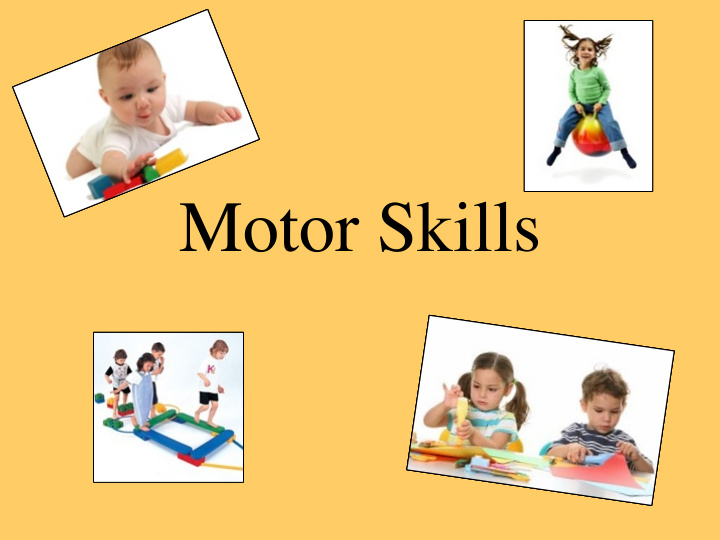



Motor Skills
What are motor skills? • A motor skill is a learned sequence of movements that combine to produce a smooth, efficient action in order to master a particular task. ! • The development of motor skill occurs in the motor cortex, the region of the brain that controls voluntary muscle groups. ! • For motor skills to develop children must have opportunities to be physically active and be able to move and explore their environment. If there are no opportunities given to move and be active then the co-ordination of motor skills cannot be developed.
Gross Motor Fine Motor Big movements using large muscles. • Motor planning Small movements using • Postural stability & tone small muscles. • Spatial & body awareness • Visual Motor Integration • Bilateral integration • Vision and Ocular Motor Control • Midline crossing & Laterality • Manual Dexterity
Motor Planning • Motor planning is the sensory process that allows a child to pick up a new activity or an unfamiliar Most of the first movements a child task, to learn the skill of makes in the first six months are how to do it automatically. automatic. By the time they are playing and learning to manipulate • A motor skill is something toys their motor planning is that a child has had to motor developing plan to learn.
Sensory Integration For effective motor planning a child needs a body that can accept and process accurate sensory information, using their tactile, visual, auditory, proprioceptive and vestibular senses. This is known as sensory integration. Without motor planning and the ability to process sensory feedback a child cannot learn appropriate motor skills and will fall behind in their motor skills milestones. Children who avoid or are not given opportunities for a wide range of sensory experiences through movement, touch and visual stimulation are likely to have problems with carrying out and learning new tasks efficiently.
Tone Postural Stability Tone refers to the muscles readiness to contract and be • Postural stability is the ability to keep one ready for action. body part stable while moving another. Low tone is a reduced readiness. • Good postural stability enables the High tone is an increased muscles of the trunk, pelvis, neck and readiness. shoulders to continuously work to keep the body upright and the head straight and steady while allowing movement of the Spatial arms and legs, so children can freely move to complete certain tasks, such as kicking a football or reaching for a toy. Spatial awareness is the ability to be aware of your place in space and your bodys position in relation to things around you.
Bilateral Integration Bilateral integration is the ability to use both sides of the body in a co-ordinated way. Hand dominance impacts on bilateral integration skill development. Hand dominance should be obvious by the time a child is around 5 ½ years old. If they continue to not have dominance they should be encouraged to adopt a dominant hand as non-dominance will impact on bilateral integration skill efficiency.
Midline crossing & Midline crossing is the ability to use limbs and eyes across the midline of the body. It means that one hand/side of the body/foot will spontaneously move over to the other side of body when completing a motor task. ! Midline is the imaginary line drawn vertically dividing the body into two equal parts. Crossing the midline happens when we cross our ankles, sit cross-legged, fold our arms across our body, reach across to the left to grab something with our right hand or read a page in a book.
Ocular Motor Visual Motor & Development Integration Vision is the act of sensing with the eyes. • Visual motor integration is the In order to process visual stimulus skill children use to process what they see with their eyes into an appropriately a child must have appropriate motor movement. It good ocular motor control. This refers to is the ability to co-ordinate the control and co-ordination of a child’s visual information with motor eye movements. output for precise visual ! guidance of To achieve adequate ocular motor control movement. the muscles in each eye must co-ordinate effortlessly to obtain a single unified and clear image for transmission via the optic nerves to the visual cortex.
Manual dexterity • Manual dexterity is the ability for the hands and fingers to make co-ordinated movements. • Strong fine motor skills, such as those used with writing, knitting, sewing, and other activities that involve the hands and fingers, rely on manual dexterity. • In young children, manual dexterity is developed normally through routine activities that also require hand-eye co-ordination.
Thank You For Listening
Recommend
More recommend